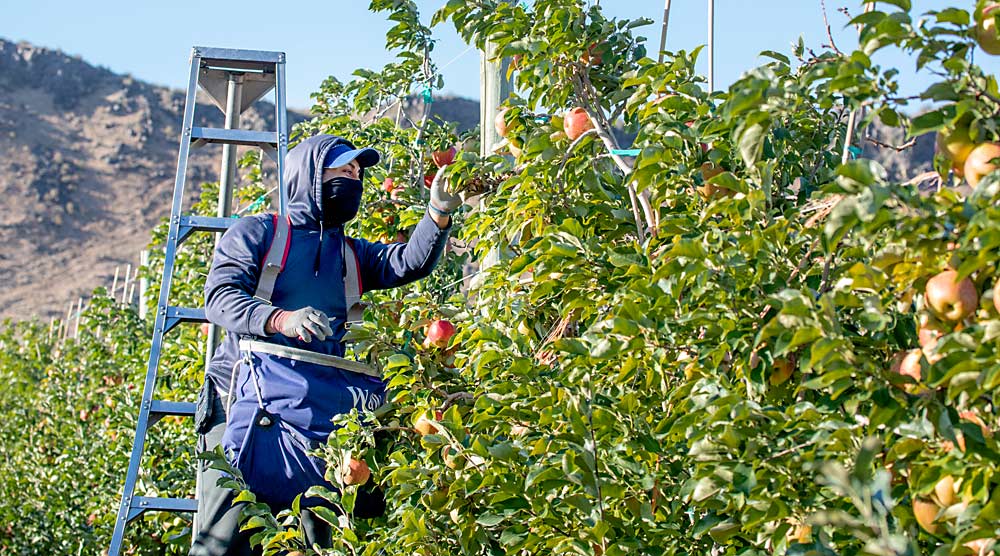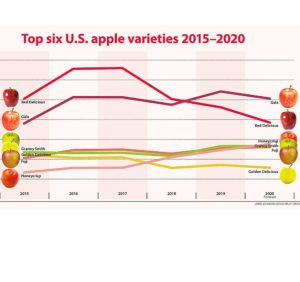
It’s been a turbulent year for the U.S. apple industry, but Jim Bair struck a note of optimism during the 2020 Apple Crop Outlook & Marketing Conference, the U.S. Apple Association’s annual gathering.
“The apple industry faced many challenges this past year but rose to meet every one of them,” said Bair, USApple’s president and CEO. “Growers and apple businesses weathered the confluence of a perfect storm this past year and came out the other side.”
The fact that the August conference was held virtually, for the first time, was one example of what has made 2020 such an unprecedented year. The coronavirus pandemic, and the resulting shutdowns, upended normal consumption, production and transportation patterns.
“We had never witnessed a situation of this scale and magnitude,” Bair said. The apple industry reacted quickly, however, adding safety measures for employees and maintaining supply to grocery stores and food banks. “What could have been catastrophic for the industry instead showed what we’re made of,” he said.
Coronavirus disruptions and trade wars combined to drive down prices as a record number of apples sat in storage in June. Though the 2019 apple crop was 8 percent larger than the 2018 crop, it was worth $200 million less, according to USApple.
Worries that too much 2019 fruit would carry over going into the 2020 harvest eased when the pace of shipments picked up in July and August. By late August, Washington state had shipped over 95 percent of its crop — right on track with previous seasons, Toni Lynn Adams, communications outreach specialist with the Washington Apple Commission, said in an interview with Good Fruit Grower.
Despite pandemic-related price declines, apple growers did not initially qualify for financial aid from the U.S. Department of Agriculture’s Coronavirus Food Assistance Program. Based on data provided by USApple, however, USDA reversed its decision in July.
Other Outlook 2020 speakers addressed the pandemic’s ripple effects.
Darren Seifer, a food and beverage industry analyst for market research company The NPD Group, said that, due to the pandemic, many more meals are being prepared at home. This and other shifts in consumer habits, such as an increase in online ordering, might not end with the pandemic, either. Fortunately, fruit consumption is up, and apples could fit well into consumer desires for comforting, healthful food.
Food and agriculture sectors have done a lot of scrambling to get their products harvested and processed during the pandemic, said Mark Moorman, director of the Food and Drug Administration’s Office of Food Safety. Moorman told the USApple audience that his office’s top job during the pandemic has been to bolster consumer confidence in the nation’s food supply. It’s spent a lot of time providing food safety and handling guidelines for manufacturers, retail chains and restaurants.
Trade
Trade disputes caused major disruptions in apple exports in the last couple of years. By August, however, trade tensions seemed to be easing, and exports were rising again. Two of USApple’s top trade priorities — the U.S.-Mexico-Canada Agreement and the U.S-China trade deal — have been ratified in the past year, Bair said.
“Growers export about $1 billion worth of apples annually, making trade a critical part of the industry,” Bair said. “While we are comforted to see export numbers rising after a nail-biting year of lost market share and plummeting grower revenues, we still have our work cut out for us to get back on steady ground.”
India, a high-value market, continues to have a 70-percent duty on imported U.S. apples, in response to U.S. steel and aluminum tariffs. Washington shipped 8 million boxes to India in 2017–18, but in 2019–20, with the tariff in place, exports dropped to 2 million boxes. China still has a 55 percent duty in place, though importers can apply for an exemption. Overall volume to China is down 51 percent, Adams told Good Fruit Grower. •
—by Matt Milkovich








Leave A Comment